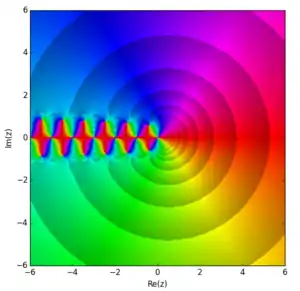Trigamma function
In mathematics, the trigamma function, denoted ψ1(z), is the second of the polygamma functions, and is defined by
- .

It follows from this definition that
where ψ(z) is the digamma function. It may also be defined as the sum of the series
making it a special case of the Hurwitz zeta function
Note that the last two formulas are valid when 1 − z is not a natural number.
Calculation
A double integral representation, as an alternative to the ones given above, may be derived from the series representation:
using the formula for the sum of a geometric series. Integration over y yields:
An asymptotic expansion as a Laurent series is
if we have chosen B1 = 1/2, i.e. the Bernoulli numbers of the second kind.
Recurrence and reflection formulae
The trigamma function satisfies the recurrence relation
and the reflection formula
which immediately gives the value for z = 1/2: .
Special values
At positive half integer values we have that
Moreover, the trigamma function has the following special values:
where G represents Catalan's constant.
There are no roots on the real axis of ψ1, but there exist infinitely many pairs of roots zn, zn for Re z < 0. Each such pair of roots approaches Re zn = −n + 1/2 quickly and their imaginary part increases slowly logarithmic with n. For example, z1 = −0.4121345... + 0.5978119...i and z2 = −1.4455692... + 0.6992608...i are the first two roots with Im(z) > 0.
Relation to the Clausen function
The digamma function at rational arguments can be expressed in terms of trigonometric functions and logarithm by the digamma theorem. A similar result holds for the trigamma function but the circular functions are replaced by Clausen's function. Namely,[1]
Computation and approximation
An easy method to approximate the trigamma function is to take the derivative of the asymptotic expansion of the digamma function.
Notes
- Lewin, L. (editor) (1991). Structural properties of polylogarithms. American Mathematical Society. ISBN 978-0821816349.CS1 maint: extra text: authors list (link)
- Mező, István (2013). "Some infinite sums arising from the Weierstrass Product Theorem". Applied Mathematics and Computation. 219 (18): 9838–9846. doi:10.1016/j.amc.2013.03.122.
References
- Milton Abramowitz and Irene A. Stegun, Handbook of Mathematical Functions, (1964) Dover Publications, New York. ISBN 0-486-61272-4. See section §6.4
- Eric W. Weisstein. Trigamma Function -- from MathWorld--A Wolfram Web Resource